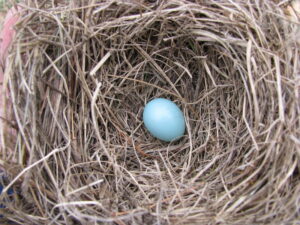Question: How long does it take a cavity nester build a nest and lay the first egg?
Answer: It depends on a variety of factors:
- weather and day length, which stimulates hormones etc.
- Note that with climate change, egg laying is happening earlier.
- brood number: e.g., bluebirds may complete the nest for a second brood much more quickly. A second or third nest of the season may be smaller, perhaps because not as much insulation is required as the weather warms.
 food availability: Birds seem to sense or are “programmed to know when there is enough for babies that need to be fed every 15-30 minutes. If food is scarce, it takes time away from nest building. E.g., Tree Swallows may abandon nests for days at a time and fly 20 miles away looking for food.
food availability: Birds seem to sense or are “programmed to know when there is enough for babies that need to be fed every 15-30 minutes. If food is scarce, it takes time away from nest building. E.g., Tree Swallows may abandon nests for days at a time and fly 20 miles away looking for food.- competition: e.g., if a bird has to spend days fighting off others of its same species or competitors, this can delay nest building. If paper wasps show up, the nester may delay completing the nest until the monitor comes and removes the wasps.
- experience: I assume older birds that show up early in the season build “better” nests fairly quickly.
- whether both male and female build the nest: this enables HOSP to build a nest very quickly – in 1 or 2 days.
- species: including fussiness. E.g., Tree Swallows only build during the morning, and seem very selective about nesting material.
- nest style and complexity: Some woodpeckers lay their eggs in a bare cavity.
- whether they have to excavate their own cavity first: puny chickadees actually can!
- availability of nesting material: whether have to search far and wide.
- synchronicity: whether nearby pairs lay eggs around the same time, perhaps so they can migrate together, as in Tree Swallows.
- type of nest made: e.g., a House Sparrow fills a nest up with trash.
The amount of time it takes for incubation to begin depends on how many eggs are laid, whether there are delays in between eggs (e.g., due to weather), and whether the bird begins incubation the day before the last (penultimate) egg is laid, or on the day the very last egg is laid.
Some examples of timetables for cavity nesters:
-
- Black-capped chickadee: Excavation: Both the male and female are involved in excavation, which can take 7-10 days.Nest construction: 3-4 days up to 2 weeks. Only the female builds the nest, which is fairly complex. Egg laying: Usually 1-2 days after nest construction.
- Eastern Bluebird: Nest building 2-6 days. Egg laying: 5-7 days. Usually laying one per day, for a total of 4-7 eggs. Often start egg laying a few days after nest is completed. Egg laying can be delayed (sometimes for a week or two – 3 weeks is not unheard of) in cold weather, for young parents, or in cases where food is scarce.
- Tree Swallow: Nest building can take 2-4 weeks, and is done only by the female, and usually only during the morning. There may be quite a gap for egg laying, but it is usually done synchronously with neighbors – i.e., neighbors lay within 7-10 days of each other (sometimes just 1-2 days apart.)
- House Sparrow: Both the male and female participate in nestbuilding. I’m trying to find data on how long after nest construction is complete, but they can definitely crank them out.
MORE INFORMATION:
Please excuse my dirty house
I know it is a mess
I don’t have time to clean right now
I have a bluebird nest ….
– Cherie Layton, The Bluebird Nut, 2005
